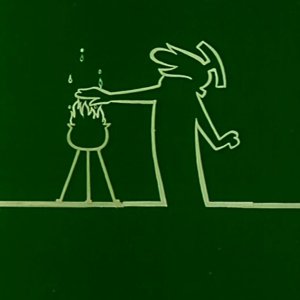If you miss all of the old detective classics then give this one a try!
This is a classic Whodunnit crime drama, only that the Who is not the question, only the How.
It has all the tropes:
* There is the eccentric genius (Enomoto), who is set apart from the world by mannerisms and interests. His personal life and background is mostly of no importance (and in this case, even a mystery),
* He has sidekicks who are mostly there to give a bit of comedy and occasionally provide some important clue
* It's case driven, not character-driven -- There's little to no character development. In fact, apart from some broad strokes, we don't know much ablout the three main characters.
* The cases are presented in episodic format, one case per episode, and in each episode there's the same clear structure.
* The way each scene is set up -- from the way Enomoto inspects the crime scenes to the spatial arrangement of the characters in key moments -- it all feels very old-school.
* And, last but not least, the background music. These new and fresh melodies are used in a classic way -- we hear the "he's thinking hard", the "the important clue is coming", the "this is the introductory scene", the "here comes the comedy part" in the respective scenes.
I am not able to explain this in detail, but it feels as if the writer and the director used these tropes very deliberately to create something new from the old. I welcomed these tropes as old friends in new clothes, rather than roll my eyes at them.
Seems boring? For case aficionados, it isn't.
The cases are, as usual sometimes a bit far-fetched, but always solidly built. If the viewer is paying attention, they can even spot the main clue or at least guess the outline of the solution. During the introductory scene, Enomoto usually gives a hint what to look out for (I only noticed that after eight episodes or so, which is a shame). Only in a few episodes there's a clue we only get told during the relevation scene.
The fresh air mostly comes from the main premise -- even though everything else is a classic "Whodunnit", it's about the "How" not the "Who". All of the cases are locked-room murders; Enomoto is a lock-smith, who is only interested in how the room can be "unlocked". As a consequence, we usually know who the culprit was very early.
Even though the characters are only painted in broad strokes, they don't come across as one-dimensional -- I felt that I knew them like new-ish colleagues, I know how they are at the work place and what to expect from them, and I know a few titbits about their private life. The script and the actors were very good at hinting at a backstory for the characters, implying that there has gone more than a few thoughts into the world-building here. This is enhanced by the excellent acting -- especially the minuscule shifts in Enomoto's face combined with his almost robotic bady language give him more depth than being just a puzzle-solver.
Overall, this is worth a watch, maybe even a second one after a few months to see if I can catch more hints and clues. I like the way the creators took the classic tropes of the detective genre and used them to their advantage to make something fresh.
It has all the tropes:
* There is the eccentric genius (Enomoto), who is set apart from the world by mannerisms and interests. His personal life and background is mostly of no importance (and in this case, even a mystery),
* He has sidekicks who are mostly there to give a bit of comedy and occasionally provide some important clue
* It's case driven, not character-driven -- There's little to no character development. In fact, apart from some broad strokes, we don't know much ablout the three main characters.
* The cases are presented in episodic format, one case per episode, and in each episode there's the same clear structure.
* The way each scene is set up -- from the way Enomoto inspects the crime scenes to the spatial arrangement of the characters in key moments -- it all feels very old-school.
* And, last but not least, the background music. These new and fresh melodies are used in a classic way -- we hear the "he's thinking hard", the "the important clue is coming", the "this is the introductory scene", the "here comes the comedy part" in the respective scenes.
I am not able to explain this in detail, but it feels as if the writer and the director used these tropes very deliberately to create something new from the old. I welcomed these tropes as old friends in new clothes, rather than roll my eyes at them.
Seems boring? For case aficionados, it isn't.
The cases are, as usual sometimes a bit far-fetched, but always solidly built. If the viewer is paying attention, they can even spot the main clue or at least guess the outline of the solution. During the introductory scene, Enomoto usually gives a hint what to look out for (I only noticed that after eight episodes or so, which is a shame). Only in a few episodes there's a clue we only get told during the relevation scene.
The fresh air mostly comes from the main premise -- even though everything else is a classic "Whodunnit", it's about the "How" not the "Who". All of the cases are locked-room murders; Enomoto is a lock-smith, who is only interested in how the room can be "unlocked". As a consequence, we usually know who the culprit was very early.
Even though the characters are only painted in broad strokes, they don't come across as one-dimensional -- I felt that I knew them like new-ish colleagues, I know how they are at the work place and what to expect from them, and I know a few titbits about their private life. The script and the actors were very good at hinting at a backstory for the characters, implying that there has gone more than a few thoughts into the world-building here. This is enhanced by the excellent acting -- especially the minuscule shifts in Enomoto's face combined with his almost robotic bady language give him more depth than being just a puzzle-solver.
Overall, this is worth a watch, maybe even a second one after a few months to see if I can catch more hints and clues. I like the way the creators took the classic tropes of the detective genre and used them to their advantage to make something fresh.
Was this review helpful to you?


 2
2











